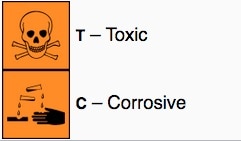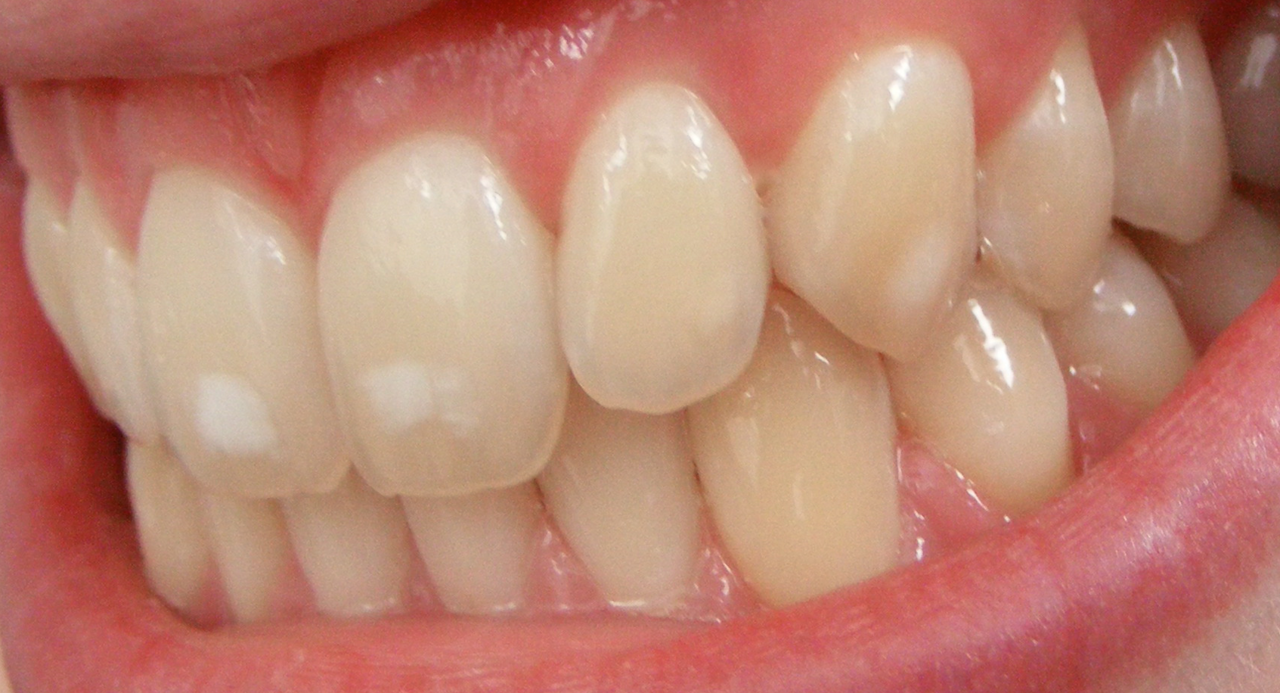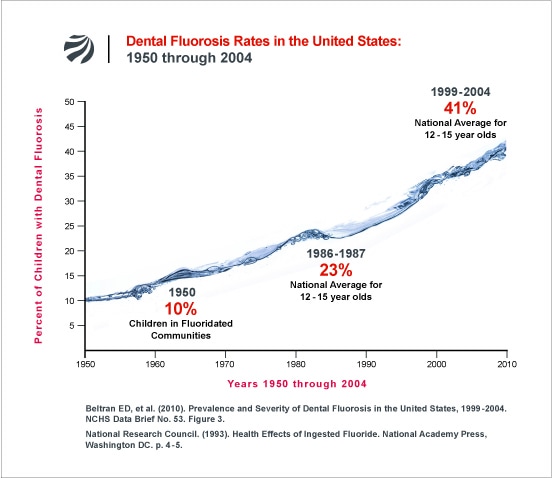Drug: a chemical that is used to treat or prevent a disease
Public health officials claim that water fluoridation exists to prevent dental decay among the masses. Fluoride happens to be the only drug that is forced on the public without their consent, and without proper knowledge of the possible side effects of consuming excess fluoride. The public is misled that ingesting fluoride helps prevent tooth tooth decay. It is one claim to state that topical fluoride may aid in the prevention of cavities, however, drinking water that is fluoridated to become absorbed, distributed and metabolized by the entire body as it enters the gastrointestinal system is a very different claim. The "crisis" of dental decay is the result, largely, of sugar abuse, especially prevalent in refined, processed foods. A large concern regarding the consumption of fluoridated water, among many, is the fact that the dose of the drug can not be controlled, regardless of age, bodyweight or sex. A growing body of evidence suggests that the various fluoride compounds, added to water supplies, toothpaste, pharmaceutical drugs, foods and packaging are not safe for human consumption.
Did you know?
Most Developed Countries Do Not Fluoridate Their Water
More people drink artificially fluoridated water in the United States alone, compared to the rest of the world combined. Most nations do not fluoridate their water. An estimated 97% of western European countries do not fluoridate their water.
Source: http://www.matrixseite.de/Texte/Fluoridation.pdf
Source: http://www.matrixseite.de/Texte/Fluoridation.pdf
Fluoridated Countries Do Not Have Less Tooth Decay Than Non-Fluoridated Countries
According to the CDC, the prevalence of dental cavities has declined in both communities with and communities without fluoridated water in the United States.
Source: CDC. (1999, October 22). Achievements in public health, 1900-1999: Fluoridation of drinking water to prevent dental Caries. Retrieved February 21, 2017, from https://www.cdc.gov/Mmwr/preview/mmwrhtml/mm4841a1.htm
Source: CDC. (1999, October 22). Achievements in public health, 1900-1999: Fluoridation of drinking water to prevent dental Caries. Retrieved February 21, 2017, from https://www.cdc.gov/Mmwr/preview/mmwrhtml/mm4841a1.htm
Fluoride Affects Many Tissues in the Body Besides the Teeth
Renowned toxicologist, Dr. John Doull, who chaired the National Academy of Science’s review on fluoride in 2006, and Doull’s committee at the NAS published an 500-page review of fluoride’s toxicity. The report concludes that fluoride is an endocrine disruptor and can affect many tissues in the body, including the bones, the brain, the thyroid gland, the pineal gland, and even blood sugar levels. The researchers implore public health officials to investigate if current fluoride exposures in the United States are contributing to chronic health problems, like bone disorders, thyroid disease, low intelligence, dementia, and diabetes, particularly in people who are most vulnerable to fluoride’s effects. These recommendations highlight that—despite 60 years of fluoridation—many of the basic studies necessary for determining the program’s safety have yet to be conducted.
Source: Committee on Fluoride in Drinking Water, Board on Environmental Studies and Toxicology, & Division on Earth and Life Studies (2006). Fluoride in drinking water: A scientific review of EPA’s standards. Washington, D.C.: National Academies Press.
Source: Committee on Fluoride in Drinking Water, Board on Environmental Studies and Toxicology, & Division on Earth and Life Studies (2006). Fluoride in drinking water: A scientific review of EPA’s standards. Washington, D.C.: National Academies Press.
Types of Fluoride Additives
It should be noted that the fluoride that is added to public water supplies is not naturally occurring fluoride. Public water supplies in the United States that are fluoridated may contain one or more of the following additives:
Fluorosilicic acid
(hydrofluorosilicate, FSA, or HFS)
(hydrofluorosilicate, FSA, or HFS)
Sodium fluoride
Sodium fluorosilicate
(CDC, 2014)
Methods of Manufacturing Fluoride
Most fluoride additives used in the United States are produced from the phosphate fertilizer industry (CDC, 2014). Fluorosilicic acid is derived directly from the smokestacks during the production of phosphate fertilizer, shipped to water treatment plants and then introduced into the public water supply. This industrial grade fluoride is contaminated with trace amounts of heavy metals such as lead, arsenic and radium.
History of Water Fluoridation
|
|
|
Influence on Health
Researchers continue to confirm that fluoride is a neurotoxin. Fluoride is classified in the same category as arsenic, lead and mercury. Neurotoxins diminish quality of life, reduce academic achievement, and disturb behavior, with profound consequences for the welfare and productivity of entire societies. Children who are exposed to fluoride in drinking water have an seven point average reduction of IQ. Another study found that children, whose mothers were exposed to fluoride during pregnancy, displayed behavioral deficits (increased risks for hyperactivity and aggressive behavior) at 2 years of age (Grandjean & Landrigan, 2014). Fluoride in drinking water has also been linked to various cancers including osteosarcoma (bone cancer) among young males (Bassin, Wypij, Davis, & Mittleman, 2006), bladder and lung cancer (Grandjean, 2004). Several research teams in India and China have reported an increased incidence of mutagenic (an agent that causes genetic mutation) effects in fluoride-exposed humans (Sheth 1994; Meng 1995, 1997; Wu 1995; Joseph 2000). One study even found that primate cells (great apes and humans) are more sensitive to fluoride’s genotoxic effects than rodents (Kishi, 1993). Fluoride is also classified as a endocrine disruptor, which can damage the bones, the brain, the thyroid gland, the pineal gland and blood sugar levels (Committee on Fluoride in Drinking Water, Board on Environmental Studies and Toxicology, & Division on Earth and Life Studies, 2006).
Recent research conducted on animals suggests that fluoride may decrease bone strength by altering the microarchitechture, thus increasing the risk of fracture (Doull et al., 2006). Fluoride has been shown to accumulate in tissues within the human body, including bone (Doull et al., 2006) and the pineal gland (Luke, 1997). The current adequate intake (AI) for fluoride is 3 mg/day for adult females and 4 mg/day for adult males (Ross, Taylor, Yaktine, & Del Valle, 2011). Most foods have concentrations of fluoride well below 0.05 mg/100 g, except fluoridated water (Young et al., 1997). Keep in mind, the chemicals used to fluoridate water (fluorosilic acid, sodium flurosilicate, sodium fluoride) are not naturally occurring (“NSF Fact Sheet on Fluoridation,” 2013).
Since bone is the principal site of fluoride accumulation, particularly during the growth spurts of childhood, the connection between fluoride and osteosarcoma is biologically plausible for the following reasons:
Researchers conducting an age-specific analysis of a national case-control study found a significant association between males that consumed fluoridated water during their mid-childhood, 6th, 7th, and 8th years of life, and the risk of developing osteosarcoma during their teenage years (Bassin, 2001).
Recent research conducted on animals suggests that fluoride may decrease bone strength by altering the microarchitechture, thus increasing the risk of fracture (Doull et al., 2006). Fluoride has been shown to accumulate in tissues within the human body, including bone (Doull et al., 2006) and the pineal gland (Luke, 1997). The current adequate intake (AI) for fluoride is 3 mg/day for adult females and 4 mg/day for adult males (Ross, Taylor, Yaktine, & Del Valle, 2011). Most foods have concentrations of fluoride well below 0.05 mg/100 g, except fluoridated water (Young et al., 1997). Keep in mind, the chemicals used to fluoridate water (fluorosilic acid, sodium flurosilicate, sodium fluoride) are not naturally occurring (“NSF Fact Sheet on Fluoridation,” 2013).
Since bone is the principal site of fluoride accumulation, particularly during the growth spurts of childhood, the connection between fluoride and osteosarcoma is biologically plausible for the following reasons:
- "the bone is the site where fluoride accumulates, with the accumulation rate higher during periods of bone formation;
- fluoride is known to stimulate bone growth;
- unscheduled or accelerated growth in tissues can lead to cancer, especially if it is accompanied by genetic damage in the dividing cells; and
- in vitro research has established that fluoride can cause genetic damage" (Connett, Neurath, & Connett, 2005).
Researchers conducting an age-specific analysis of a national case-control study found a significant association between males that consumed fluoridated water during their mid-childhood, 6th, 7th, and 8th years of life, and the risk of developing osteosarcoma during their teenage years (Bassin, 2001).
Fluoride Causes Dental Fluorosis
|
Flouridated water is been consistently correlated with dental fluorosis, a condition where the teeth become mottled. Fluorosis is a visible sign of systemic toxicity. Teeth are not the only tissues in which fluoride accumulates. Dental fluorosis is more than an aesthetic issue, let alone a psycholigcal issue; severe forms of fluorosis are associated with an increase in dental decay (Committee on Fluoride in Drinking Water, Board on Environmental Studies and Toxicology, & Division on Earth and Life Studies, 2006).
Dental fluorosis is especially prevalent among children between the ages of 12 -15. “In 1986–1987, 22.6% of adolescents aged 12–15 had dental fluorosis, whereas in 1999–2004, 40.7% of adolescents aged 12–15 had dental fluorosis. . . . The prevalence of very mild fluorosis increased from 17.2% to 28.5% and mild fluorosis increased from 4.1% to 8.6%. The prevalence of moderate and severe fluorosis increased from 1.3% to 3.6%” (Beltrán-Aguilar ED, et al., 2010). Researchers have observed that tooth decay decreases over time in communities that end water fluoridation, compared to a stable rate of tooth decay in communities that remain fluoridated (Maupomé, Clark, Levy, & Berkowitz, 2001).
|
The Solution: Use a Filter, or Your Body Becomes a Filter
References
Bassin, E. B. (2001, April ). Association Between Fluoride in Drinking Water During Growth and Development and the Incidence of Osteosarcoma for Children and Adolescents. Retrieved February 21, 2017, from http://www.fluoridealert.org/wp-content/uploads/bassin-2001.pdf
Bassin, E.B., Wypij, D., Davis, R.B. et al. Cancer Causes Control (2006) 17: 421. doi:10.1007/s10552-005-0500-6
Beltrán-Aguilar ED, et al. (2010). Prevalence and Severity of Dental Fluorosis in the United States, 1999–2004. Centers for Disease Control. NCHS Data Brief No. 53.
Committee on Fluoride in Drinking Water, Board on Environmental Studies and Toxicology, & Division on Earth and Life Studies (2006). Fluoride in drinking water: A scientific review of EPA’s standards. Washington, D.C.: National Academies Press.
Connett, P., Neurath, C., & Connett, M. (2005, March 21). Revisiting the Fluoride-Osteosarcoma connection in the context of Elise Bassin’s findings: Part II. Retrieved February 11, 2017, from U.S. Department of Health and Human Services - National Toxicology Program, https://ntp.niehs.nih.gov/ntp/roc/nominations/2016/publiccomm/appendix1b_508.pdf
CDC. (2014, December 22). Water Fluoridation additives fact sheet. Retrieved February 4, 2017, from Centers for Disease Control and Prevention, https://www.cdc.gov/fluoridation/factsheets/engineering/wfadditives.htm
Grandjean, P., & Landrigan, P. J. (2014). Neurobehavioural effects of developmental toxicity. The Lancet Neurology, 13(3), 330–338. doi:10.1016/s1474-4422(13)70278-3
http://fluoridealert.org/articles/fluoride-facts/
Maupomé, G., Clark, D., Levy, S., & Berkowitz, J. (2001). Patterns of dental caries following the cessation of water fluoridation. Community dentistry and oral epidemiology., 29(1), 37–47. Retrieved from https://www.ncbi.nlm.nih.gov/pubmed/11153562
Poti, J. M., Mendez, M. A., Ng, S. W., & Popkin, B. M. (2015). Is the degree of food processing and convenience linked with the nutritional quality of foods purchased by US households? The American Journal of Clinical Nutrition. doi:10.3945/ajcn.114.100925
Bassin, E.B., Wypij, D., Davis, R.B. et al. Cancer Causes Control (2006) 17: 421. doi:10.1007/s10552-005-0500-6
Beltrán-Aguilar ED, et al. (2010). Prevalence and Severity of Dental Fluorosis in the United States, 1999–2004. Centers for Disease Control. NCHS Data Brief No. 53.
Committee on Fluoride in Drinking Water, Board on Environmental Studies and Toxicology, & Division on Earth and Life Studies (2006). Fluoride in drinking water: A scientific review of EPA’s standards. Washington, D.C.: National Academies Press.
Connett, P., Neurath, C., & Connett, M. (2005, March 21). Revisiting the Fluoride-Osteosarcoma connection in the context of Elise Bassin’s findings: Part II. Retrieved February 11, 2017, from U.S. Department of Health and Human Services - National Toxicology Program, https://ntp.niehs.nih.gov/ntp/roc/nominations/2016/publiccomm/appendix1b_508.pdf
CDC. (2014, December 22). Water Fluoridation additives fact sheet. Retrieved February 4, 2017, from Centers for Disease Control and Prevention, https://www.cdc.gov/fluoridation/factsheets/engineering/wfadditives.htm
Grandjean, P., & Landrigan, P. J. (2014). Neurobehavioural effects of developmental toxicity. The Lancet Neurology, 13(3), 330–338. doi:10.1016/s1474-4422(13)70278-3
http://fluoridealert.org/articles/fluoride-facts/
Maupomé, G., Clark, D., Levy, S., & Berkowitz, J. (2001). Patterns of dental caries following the cessation of water fluoridation. Community dentistry and oral epidemiology., 29(1), 37–47. Retrieved from https://www.ncbi.nlm.nih.gov/pubmed/11153562
Poti, J. M., Mendez, M. A., Ng, S. W., & Popkin, B. M. (2015). Is the degree of food processing and convenience linked with the nutritional quality of foods purchased by US households? The American Journal of Clinical Nutrition. doi:10.3945/ajcn.114.100925












